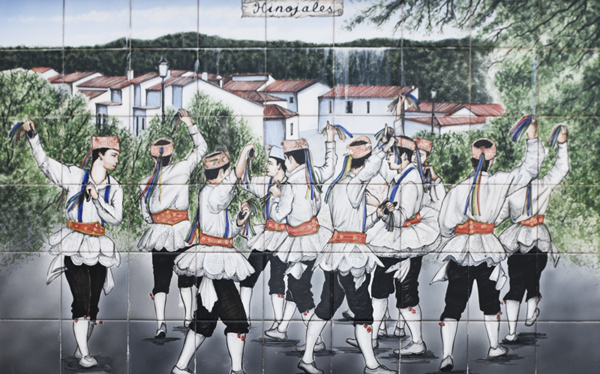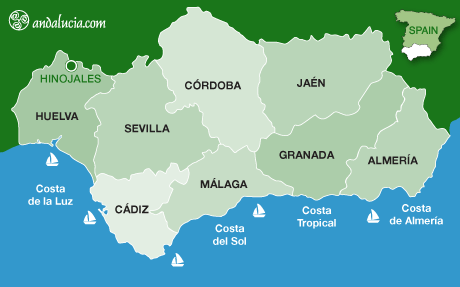
The cobbled streets and exotic plants of Hinojales |
|
HInojales
by Saskia Mier
Hinojales is located within the Sierra de Aracena and Picos de Aroche Natural Park, in the far north of the province, west of Cañaveral de León. It is situated within limits of villages in Badajoz (Extremadura, the region north of Andalucia) and has approximately 392 inhabitants.
HISTORY
A Bronze Age burial site near the town centre, although not studied in detail, dates the village back to that era .From the Visigothic settlement, an early Christian gravestone dated 568 AD can be seen in the Ermita de Tórtola; from this cultural period remains to this day the Danza Virgen de la Tortola.
Muslim placenames remain, such as "Cueva del Moro" and "El Horno del Moro". The name of Hinojales, originally from Castille when they freed the Sierra from Portuguese invasion, means "land of abundant fennel".
Hinojales relates to the post-Reconquest immigration of inhabitants from Galicia and Leon in the 15th century, who traditionally painted "pinturas al fresco" (frescoes) within all churches they built.In the 16th century, King Carlos I granted Hinojales independence from Aracena.
Another interesting fact is that the Civil War did not affect Hinojales, as the Republican mayor at the time, Pedro Uceda, urged citizens to put aside political grudges so that no accusations could be made between villagers, so no blood shed ensued.
THINGS TO SEE
Iglesia de Nuestra Señora de Consolación
This Gothic-Mudejar style church was built in the late 15th century, possible on the ruins of a castle. The low building is beautifully simple, with a very unusual façade: plain white, single-storey, witha stone Gothic archway with fine arch detail above, while the interior boasts pinturas al fresco from the late 15th or early 16th century, as well as several polychrome images from the 16th and 18th centuries.
Ermita de Nuestra Señora de Tórtola
Baroque-style chapel built in the 18th century on the site of a previous temple. It contains a Paleo-Christian tombstone from 568 AD, left by Visigoths, plus a bell tower and a weather vane of a dove.
Hotels in Hinojales
Book Hotels in Hinojales
COUNTRYSIDE WALKS
Hinojales offers visitors many opportunities to experience nature, walking among the diverse landscape of banks, valleys and mountains with a number of routes for hikers, although these are not marked except one called "Sendero de la Vibora".
Thiseasy 1.6 km route leads north-east from the village, right up to the border between Andalusia and Extremadura. Lined with fig trees, holm oaks and olive groves, the route ends in a meadow of cork oaks and joins a cattle route called "Colada de las Tablas".
GASTRONOMY
The Iberian pig is a staple in Hinojales, and is used to make products and dishes similar to those found in other villages in the Sierra. However, uniquely local dishes include caldillo de matanza (pork stew with offal, dried fruits and aromatic plants), bollo de patatas (potato buns) and escabeche de jabichas.
Recently, meat marinades have become very popular in Hinojales, especially for chicken, roast pork and liver. The variety of wild products, especially mushrooms and asparagus, are also highly prized, as well as rich goat's cheeses and local olive oil. All dishes are accompanied by homemade bread baked in traditional wood ovens.
HANDICRAFTS
Popular crafts in Hinojales include woodcrafting of domestic utensils (plates, spoons, forks, pestles, bowls etc.). The rich abundance of olive trees allow for basket weaving and with a few workshops to visit.
FESTIVALS
Fiestas de Nuestra Señora de la Tórtola
Celebrated from 30 April to 3 of May, the main attraction of this festival is the dance known as ''Danza de la Tórtola'' or ''Lanza''. said to be of Celtic origin from written information dating from the 6th century (the stone in La Hermita de la Tórtola), or possibly 13th - 14th century from Galician and Leaonese settlers. The dance consists of an odd-numbered group of me (either seven or nine) who dance to the patroness, the Virgen de Tórtola, without turning their backs on the bagpipes and tambourines. The outfit is unusual, with dark blue knickerbockers, white stocking and shoes, long white shirts with blue straps and red belts, and beribboned flower-dcorated headpieces.
Fiestas de "Los Tosantos"
Celebrated on 1 November (All Saints Day), children equipped with a bell and basketroam the streets shouting "La Santa Paz" and ringing the bell. As they stop off at every door, something is given to fill their basket such as fruits, sweets, soft drinks, sausages and bread. They then go to the church, climb the belfry and eat the food collected together.
Carnaval
Celebrated in February.
LOCATION
Hinojales is located 143 km from Huelva. Take the N-435 to Trigueros, take A-461 to Campofrio and the A-479 passing Cañaveral de Leon.

